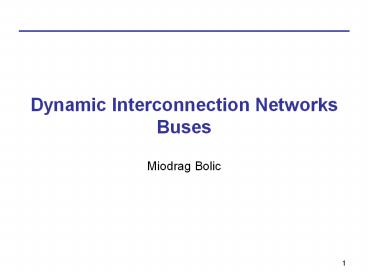Dynamic Interconnection Networks Buses - PowerPoint PPT Presentation
Title:
Dynamic Interconnection Networks Buses
Description:
All bus transaction steps take place at a fixed clock edges. simple to control ... 1 Setup Cycle. 0 Wait Cycles. 1 Hold Cycle. 27. References ... – PowerPoint PPT presentation
Number of Views:300
Avg rating:3.0/5.0
Title: Dynamic Interconnection Networks Buses
1
Dynamic Interconnection NetworksBuses
- Miodrag Bolic
2
Overview
- Basic theory on buses
- Arbitration
- High performance bus protocols
- Avalon bus
3
Big Picture
Focus of this lecture
Interconnection Networks
4
Interconnection Network Taxonomy 5
Interconnection Network
Dynamic
Static
Bus-based
Switch-based
1-D
2-D
HC
Crossbar
Single
Multiple
SS
MS
5
Addressing and Timing 2
- Bus Addressing
- Broadcast
- write involving multiple slaves
- Synchronous Timing
- All bus transaction steps take place at a fixed
clock edges - simple to control
- suitable for connecting devices having relatively
the same speed - Asynchronous Timing
- based on a handshaking
- offers better flexibility via allowing fast and
slow devices to be connected in the same bus.
Typical time sequence when information is
transferred from the master to slave.
6
Bus arbitration
- Bus arbitration scheme
- A bus master wanting to use the bus asserts the
bus request - A bus master cannot use the bus until its request
is granted - A bus master must signal to the arbiter the end
of the bus utilization - Bus arbitration schemes usually try to balance
two factors - Bus priority the highest priority device should
be serviced first - Fairness Even the lowest priority device should
be allowed to access the bus - Bus arbitration schemes can be divided into
several broad classes - Daisy chain arbitration (not used nowadays)
- Arbitration with the independent request and
grant - Distributed arbitration
7
Independent Request and Grant 1
- Multiple bus-request and bus-grant signal lines
are provided for each master - Any priority-based or fairness based bus
allocation can be used. - Advantages
- flexibility
- faster arbitration time
- Disadvantages
- large number of arbitration lines
8
Bus allocation techniques 1
- Round-robin
- The request that was just served should have the
lowest priority on the next round - TDMA
- Fixed allocation of the slot to the master
- Unequal-priority protocol
- Each processor is assigned a unique priority.
- Additional procedures are required to establish
fairness
9
Bus Pipelining 1
- Several cycles are needed to read or write one
data - Since the bus is not used in all cycles,
pipelining can - be used to increase the performance
- AR Arbitration request,
- ARB cycle for processing inside the arbiter,
- AG Grant signal is set
- RQ request signal is set
- P- pause
- RPLY reply from the memory or I/O
10
Bus Pipelining 1
11
Split Transactions 1
- In a split-transaction bus a transaction is
divided into a two transactions - request-transaction
- reply-transaction
- Both transactions have to compete for the bus by
arbitration
12
Split Transactions 1
13
Burst Messages 1
14
Avalon Bus
- Proprietary bus specification used with Nios II
- Principal design goals of the Avalon Bus
- Address Decoding
- Data-Path Multiplexing
- Wait-State Insertion
- Arbitration for Multi-Master Systems
- Transfer Types
- Slave Transfers
- Master Transfers
- Pipelined Transfers
- Burst transfers
Nios Processor
Switch PIO
Address (32)
32-BitNiosProcessor
Read
Avalon Bus
Write
LED PIO
Data In (32)
Data Out (32)
7-SegmentLED PIO
IRQ
IRQ (6)
PIO-32
User-Defined Interface
ROM(with Monitor)
UART
Timer
15
Traditional Multi-Masters
- Direct Memory Access (DMA)
- Processor Waits For Bus During DMA
Masters
System CPU (Master 1)
Bottleneck Arbiter Determines Which Master Has
Access To Shared Bus
Control direction
DMA Bus Arbiter
DMA Arbitor
System Bus
I/O 1
I/O 2
Data Memory
Program Memory
Slaves
16
Simultaneous Multi-Master Bus
Master 1 (Nios CPU)
Master 2 (100Base-T)
I
D
Masters
Control direction
Avalon Bus
Avalon Bus
Slaves
Arbiter
Uses Fairness Arbitration
I/O 1
I/O 2
Data Memory 1
Program Memory
17
Master Arbitration Scheme
- Nios Multi-Master Avalon Bus utilizes Fairness
arbitration scheme - Each Master/Slave pair is assign an integer
shares - Upon conflict Master with most shares takes bus
until all shares are used - Master with least shares then takes bus until all
shares are used - Assuming all Masters continuously request the
bus, they will each be granted the bus for a
percentage of time equal to the percentage of
total master shares that they own
18
Set Arbitration Priority
- View gt Show Arbitration Priorities
19
Address Decoding 4
20
Data-Path Multiplexing 4
21
Master Read Transfer 3
- Assert addr, be, read
- Wait for waitrequest 0
- Read in Data
- End of transfer
22
Master Write Transfer 3
- Assert addr, be, read
- Assert Write Data
- Wait for waitrequest 0
- End of transfer
23
Slave Read Transfer 3
- 0 Setup Cycles
- 0 Wait Cycles
24
Slave Read Transfer 3
- 1 Setup Cycle
- 1 Wait Cycle
25
Slave Write Transfer 3
- 0 Setup Cycles
- 0 Wait Cycles
- 0 Hold Cycles
26
Slave Write Transfer 3
- 1 Setup Cycle
- 0 Wait Cycles
- 1 Hold Cycle
27
References
- W. Dally, B. Towles, Principles And Practices Of
Interconnection Networks, Morgan Kauffman, 2004. - K. Hwang, Advanced Computer Architecture
Parallelism, Scalability, Programmability,
McGraw-Hill 1993. - Altera Corp., Avalon Interface Specification,
2005. - Altera Corp., Quartus II Handbook, Volume 4, 2005
- H. El-Rewini and M. Abd-El-Barr, Advanced
Computer Architecture and Parallel Processing,
John Wiley and Sons, 2005.































